|
You're a Grand Old Flag(pole) By Carla Kelly, former Fort Union Park Ranger
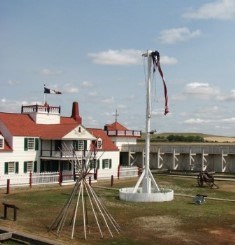
NPS Photo In August of 2007, with a crack heard around The combination of wind, a tangled flag, and rot did the deed. "Time and weather took its toll," Muzzle Loader Paul Bauer said. On June 20, 2009, a new flagpole built by that same group of fur traders will be dedicated during Rendezvous. It's still a symbol of what happens when people work together for a common goal. The new flagpole has demonstrated a remarkable capacity to reconnect friends. Bauer was one of the early members of FUMLA, who, through the years, had left the organization to concentrate on other projects. It had been ages since he had been to a Rendezvous, but when he came in 2008 and looked at the truncated remains of the old pole, something happened. "This isn't good," he remembered thinking. The solution was obvious. The Muzzle Loaders started a conversation with Andy Banta, superintendent at 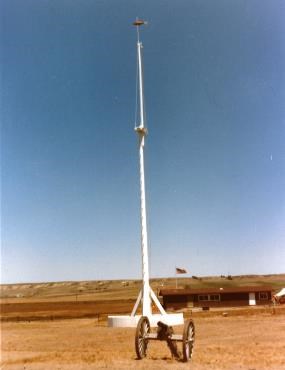
Nps Photo Banta was particularly pleased with the Muzzle Loaders' interest in crafting a second flagpole. The staff at "We ended up with the best possible plan," Banta said. "The Muzzle Loaders Association would rebuild the flagpole, and the Friends of Fort Union –through North Star Caviar –would provide $10,000." The fur trader reenacting group certainly knew how to tackle a new flagpole. They had done it in 1985, back when visiting Through the years, there had been discussion about reconstructing Adding a flagpole to the mix helped turn the talk into action. In 1982, Dave Finders moved to town from 
Photo Courtesy Paul Bauer Unknown to Finders, his wife placed an advertisement in the paper and on the radio, inviting folks to a meeting to jump start the group. Finders remembers, "Vicki told me, 'You're going to the bank basement tonight to talk to a lot of people.'" There were, and Finders did, which led to the Fort Union Muzzle Loaders Association. One of the first items on the agenda was to build a flagpole at The first hurdle was getting permission, which was hard to come by until Paul Hedren became superintendent in 1984. Fresh from Golden Spike National Historic Site, Hedren was a newly minted and ambitious superintendent. "Paul was all for it," Finders said. Through Hedren, the Muzzle Loaders connected with Rick Cronenberger, historical architect with the National Park Service. Using old documents and illustrations, Cronenberger drew the plans for a replica of the pole that had graced According to the Muzzle Loaders, donations came from all over town for the flagpole, indicative of community interest that would soon lead to the donation of many more dollars for the fort's reconstruction. 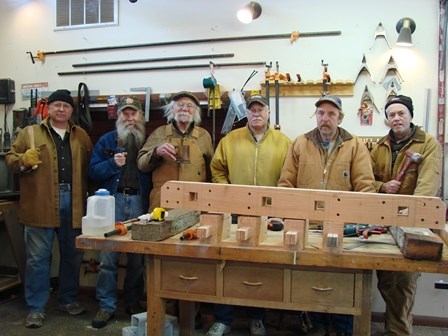
Photo Courtesy Paul Bauer The first flagpole came from Montana Dakota Utilities lumber yard. The flagpole was built on site, complete with the crosspiece crow's nest, climbing pegs and "fishy" weathervane.The flagpole, 63 feet high from the ground up, went into an augur-dug hole to a depth of seven or eight feet, precisely where the first pole had been located. Archeologists had found remnants of the first pole, and even underground cedar crosspieces. And the rest truly was history. "I think the flagpole watches over the fort," Finders said. What came next was the Bourgeois House in 1987, followed by the palisades and bastions in 1989 and the Indian trade house in 1991. What stands today is called a partial reconstruction. The flagpole history has repeated itself, using many of the same builders and Cronenberger's old plans. Bauer has nothing but admiration for the Muzzle Loaders' abilities, which have matured over the years. "It's been a real treat to work with the skill sets each member brings to the project," he said. "For example, Dave Evanson is a master cabinet maker, and Roger Olson lays down beautiful welds on the iron work. Everybody is willing to pitch in." 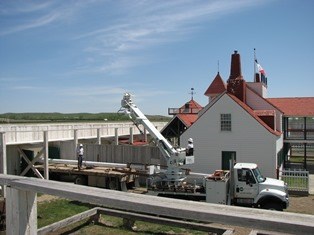
Photo Courtesy Paul Bauer "We were a lot younger when we did the first one," Evanson said, "but we learned a lot. We used better materials this time. It should last a long time." The vision of time will play into the 2009 dedication. Superintendent Paul Hedren, now retired and living in Omaha, Nebraska, has been invited to speak about the past. Current superintendent Andy Banta will speak about the present and future, according to Bauer. But first the flagpole needs to get to the fort. Because, obviously, there are buildings now where once there was an open field, this flagpole had to be constructed at Bauer's house, with the Muzzle Loaders working evenings and on weekends. The builders were able to reuse the metal and parts of the picket fence that surrounded the old pole. The weathervane fish took a nosedive in 2007, but has been repaired and will top the new pole. 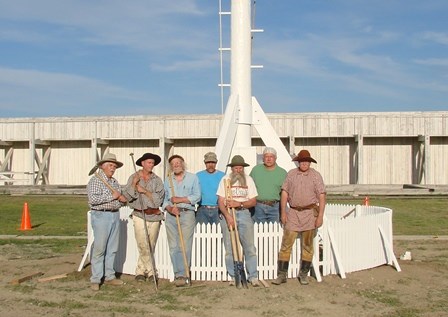
Photo Courtesy Paul Bauer Lower Yellowstone REA will transport the assembled pole to the trading post. There will be a bucket truck inside the courtyard to set the pole. The Muzzle Loaders will complete the finish work on site, and the dedication will be June 20, during the annual rendezvous. "We really appreciate the Muzzle Loaders' dedication," Banta said. "They carried our efforts forward in such a timely fashion. It seems so fitting, too, since they constructed the first flagpole." "It's been a pleasure to work on the pole," Bauer said recently, as he looked around his living room, full of his flagpole buddies. "For me, it's also been a way to reconnect with friends." 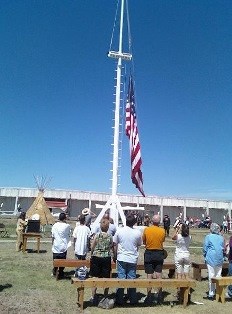
Photo Courtesy Wendy Johnson In Appreciation For All Their Accomplishments (excerpted from the 2009 Flagpole Dedication Program) A special thanks to the following members of the Fort Union Muzzle Loaders for volunteering over 350 hours during the construction of the new flag pole: Dennis and Mary Borud Thank you Friends of Fort Union for funding this project. Thank you to the following businesses that made this possible: Lower Yellowstone Electric Cooperative Thank You to the following National Park Service Employees for their participation during installation. Tim Sipper |
Last updated: April 23, 2021
